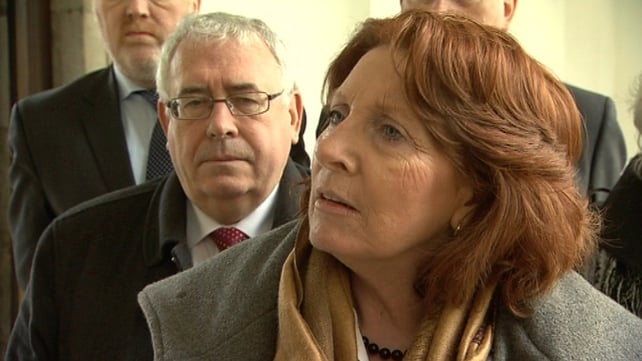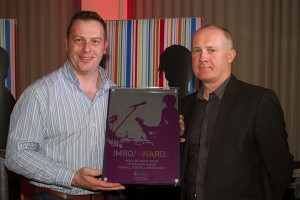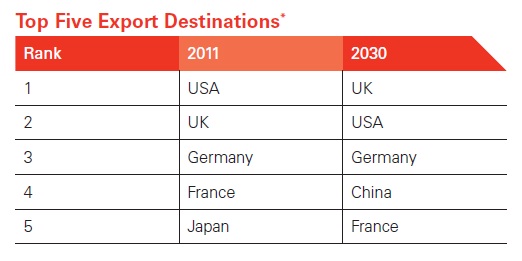Irish economy recovery begins as employment figures grow


The unemployment rate remained at 14.1 per cent in February, unchanged from January.
Employment figures published today give the strongest indication in half a decade that economic recovery has begun.
For the first time since the recession started in 2008, the numbers at work in the economy have risen over a six month period.
In the final quarter of the year, 1.85 million people were in jobs, a rise of 6,500 on three months earlier, according to seasonally adjusted figures from the Central Statistics Office.
Revisions to the third quarter data now show that growth was also recorded in that period. It is the first time since employment began to contract in 2008 that jobs growth has been recorded in two consecutive quarters.
This growth, combined with people leaving the jobs market, led to a decline in the numbers formally unemployed by more than 12,000 between the third and fourth quarters of last year.
The number of unemployed stood at 303,500 in the final three months of last year. That amounts to 14.2 per cent of the labour force.
The gradual decline in the unemployment rate has been on-going for a year. It peaked at 15 per cent at the beginning of 2012.
The momentum in the labour market in the second half of last year appears to have continued into 2013.
Separate figures on the jobless benefit claimant count, also published today by the CSO, show the numbers in receipt of benefits continued to fall in the first two months of the year.
In February, 428,000 people were receiving unemployment benefits on a seasonally adjusted basis. This is more than 20,000 lower than the peak figures, reached eighteen months ago.
From these figures, the CSO estimates that the unemployment rate stood at 14.1 per cent in February.
CSO figures show that 87,000 people left Ireland in the 12 months to April 2012, including 46,500 Irish nationals.
The CSO household survey on the labour market found the biggest annual increases in employment were in agriculture, forestry and fishing, up 12.1 per cent or 9,7000. The information and communication sectors were up 7 per cent or 5,400.
Irish Government pledges new scheme to take place of mobility allowance and motorised transport grant


Taoiseach Enda Kenny has told the Dáil that over €10m, allocated for the mobility allowance and the motorised transport grants this year, will be ring-fenced for a new scheme that will be legally compliant.
Mr Kenny said that the Government had no choice but to close the grants to new applicants and that it would spend the next four months devising the new scheme.
The schemes will be closed to new applicants with immediate effect.
Those currently in receipt of the mobility allowance will continue to receive it for another four months.
Fianna Fáil leader Micheál Martin told the Dáil that 5,000 people would be affected by the move and described it as scandalous and reprehensible.
Earlier, Minister of State Kathleen Lynch said the Government “agonised” over its decision to scrap schemes, but had no choice.
The minister said that they were illegal, and could have cost the Exchequer between €170m and €300m to extend eligibility to them in order to comply with the Equal Status Act.
Ms Lynch said she was aware of the hardship the decision would impose.
However, she said the Government could not afford to extend the scheme and could not continue to operate outside the law.
Ms Lynch said the money that funded the scheme has been ring-fenced.
She said that HSE is conducting a review into the transport needs of those in receipt of the payments, and that the “only reassurance” she could offer them is that those needs will be met into the future.
The minister also said that a “full Government approach” was being taken to examine how to introduce a universally accessible transport system.
Decision came as ‘bolt out of the blue’
Ombudsman Emily O’Reilly has said the Government gave no indication it was going to scrap the mobility allowance and motorised transport grant scheme.
Ms O’Reilly said the decision came as a “bolt out of the blue”.
A few months ago, the Ombudsman had found that the schemes were being operated illegally by the Department of Health and the HSE.
Their operation contravened the Equal Status Act because they excluded applicants over 66 years and she had recommended that they be brought in line with the law.
After initially accepting her recommendation in April 2011, Ms O’Reilly said the department said last year that these changes would be too expensive.
However, she said that just three weeks ago Minister for Health James Reilly and Minister of State Kathleen Lynch gave no indication that the schemes would be scrapped when they appeared before an Oireachtas committee.
Instead, Ms O’Reilly said they had announced that a review group would be set up to examine the schemes and bring them in line with the law.
The Ombudsman said she understands that the decision to scrap the scheme followed advice from the Attorney General.
In a statement last night, Ms O’Reilly said she hoped that the Government’s promised review of the transport needs of people with disabilities would proceed as speedily as possible.
She said it is entirely regrettable that the department’s failure to tackle these matters in a timely, coherent and rational manner has now imposed hardship on more than 5,000 people with disabilities, who will find their transport needs compromised when the schemes are discontinued.
Disability Federation CEO ‘appalled’ by decision
Disability Federation of Ireland CEO John Dolan said he is “appalled” at the decision to discontinue the schemes.
Speaking on RTÉ’s Morning Ireland, Mr Dolan said that news of the cut had come “out of the blue”, and compared it to the consultation process that preceded the new agreement on the public service agreement.
“We have here, no consultation, no engagement, out of the blue comes a statement that says people who are living on less than €200 a week, €10,000 a year, with an extra at the max of this scheme, an extra €2,500, will have that taken away, that’s a 20%, an up to 20% cut,” Mr Dolan said.
“This strikes right at the heart of people who are already, like everyone else, struggling to make ends meet.”
Mr Dolan said that despite a three-year review of the Department of Health’s Disability Services Programme, the department choose not to review these travel allowances, even though it was aware of the Ombudsman’s concerns that their terms were too narrow.
He was critical of what he called the department’s “Bart Simpson approach” where he said it seeks to blame others for the decisions it makes, which have a negative impact on those with disabilities.
“This department is a sick bureaucratic monster, if you go back to last August it blamed the Troika for taking €10m out of PA (personal assistant) services for people with disabilities, yesterday and today it’s blaming the equality legislation and the Ombudsman.
“There is a major issue for a Government that says it’s beyond Kathleen Lynch and it’s beyond the Department of Health.
“There’s an issue here for the Government to get to grips with a department that seems to be coming up with a Bart Simpson approach to everything, it’s always someone else’s fault that we have to screw people with disabilities to the floor.”
Disability rights campaigner Suzy Byrne described the decision to end the schemes as a “disgrace”.
She said the decision will hit those on waiting lists for the allowances very hard.
Up to 4,700 people receive a mobility allowance and 300 receive a motorised transport grant.
China is Ireland’s next major key export destination
China is expected to become the fourth biggest export destination for Ireland by 2030, experts have predicted.
HSBC’s global trade forecasts have identified the UK, the USA and German as the top three destinations.
But it said that the main growth areas for its exports lie in emerging Asia.
“This is evidenced by forecasted growth in exports to China of 11pc per annum in the period 2016 to 2030,” HSBC said.
“Alongside China, the forecasts also show India and Vietnam as the fastest-growing export markets to 2030, with Malaysia and Indonesia also becoming increasingly important.”
Ireland’s overall export performance is expected to be relatively favourable compared to its Western European peers.
Exports will be driven by chemicals, pharmaceuticals, scientific apparatus, and IT equipment.
Monroe’s of Galway is Ireland’s music Venue of Year 2012


Galway music venue Monroe’s has been named the IMRO Live Music Venue of the Year.
The winners in the Regional Categories were: The Olympia (Dublin); The Set Theatre, Kilkenny (Rest of Leinster); Glór Irish Music Centre, Ennis, Co Clare (Munster); McGrory’s, Culdaff, Co Donegal (Ulster) and Róisín Dubh, Galway (Connacht).
Electric Picnic was named IMRO Festival of the Year and @ The Marquee Cork was IMRO Best Small Festival.
The overall winner of the Hot Press Live Music Venue of the Year was The O2, as voted for by readers, with special commendations for the Set Theatre in Kilkenny and the Cork Opera House.
Victor Finn, CEO of the Irish Music Rights Organisation (IMRO), said: “An extensive and vibrant venue network is the lifeblood of any strong live music sector. These awards acknowledge and applaud those venues and festivals throughout Ireland that excel in creating a memorable and exhilarating environment for music fans and performers alike.
“We would like to congratulate all of the winning and nominated venues and festivals and pay tribute to the contribution that they make to local communities from a cultural and economic perspective.”
Fish oil can protect people against skin cancer,
A new study claims
Taking a regular dose of fish oil rich in omega-3 could help protect against skin cancer, a new study has claimed.
The University of Manchester researchers carried out the first clinical trial to examine the impact of the fish oil on the skin immunity of volunteers.
The study found that taking a regular dose of fish oil boosted skin immunity to sunlight. Specifically, it also reduced sunlight-induced suppression of the immune system, known as immunosuppression, which affects the body’s ability to fight skin cancer and infection.
Led by Professor Lesley Rhodes, Professor of Experimental Dermatology from the Photobiology Unit Dermatology Centre at the University, researchers analysed the effect of taking omega-3 on 79 healthy volunteers.
“There has been research in this area carried out on mice in the past but this is the first time that there has been a clinical trial directly in people,” Rhodes said.
“This study adds to the evidence that omega-3 is a potential nutrient to protect against skin cancer,” she said.
“Although the changes we found when someone took the oil were small, they suggest that a continuous low level of chemoprevention from taking omega-3 could reduce the risk of skin cancer over an individual’s lifetime,” she said in a statement.
Patients who volunteered for the trial took a 4g dose of omega-3, which is about one and a half portions of oily fish, daily and were then exposed to the equivalent of either 8, 15 or 30 minutes of summer midday sun in Manchester using a special light machine.
Other patients took a placebo, before being exposed to the light machine. Immunosuppression was 50 per cent lower in people who took the supplement and were exposed to 8 and 15 minutes of sun compared with people who did not take the supplement.
The study showed little influence on those in the 30 minute group.
Rhodes, who also works at Salford Royal NHS Foundation Trust, stressed that the omega-3 was not a substitute for sunscreen and physical protection, and that omega-3 should be regarded as an additional small measure to help protect skin from sun damage.
Rhodes’ team is now continuing their research with further omega-3 studies being carried out on healthy volunteers at Salford Royal.
Can Olive Oil and Nuts Prevent Heart Attacks?


A NEW STUDY, JUST PUBLISHED ONLINE IN THE PRESTIGIOUS NEW ENGLAND JOURNAL OF MEDICINE, WAS ABLE TO PROVE THAT DIET — A TASTY AND RATHER EASY TO KEEP ONE, AT THAT — WAS ABLE TO REDUCE STROKE AND HEART DISEASE BY 30 PERCENT.
The study, led by Dr. Ramón Estruch from Barcelona, Spain, involved 7,447 people ages 55 to 80, all at higher risk for heart disease due to diabetes or at least three risk factors for heart disease, such as obesity, smoking, high blood pressure, elevated levels of bad cholesterol, or a family history of early heart disease.
Participants were randomly assigned to one of three groups:
- Mediterranean diet supplemented with approximately four cups a week of extra-virgin olive oil (EVOO)
- Mediterranean diet supplemented with an additional ounce daily of walnuts, hazelnuts, and almonds
- Control group that was counseled to eat a low-fat diet that did not include olive oil or nuts. This group received small nonfood gifts.
Both Mediterranean diet groups were encouraged to consume olive oil, nuts, fresh fruits and veggies (at least five a day), legumes, white meat and wine in moderation with meals, and discouraged from soft drinks, commercial bakery goods such as pastries and sweets, and red meat.Sofrito (a sauce made with tomatoes, onions, garlic and herbs, slowly simmered with olive oil) was also recommended — at least two servings a week.
The control group was advised to eat low-fat dairy, fruits and veggies (at least five a day), lean fish and seafood, and discouraged from vegetable oils (including olive oil), commercial bakery goods, nuts, fried foods, red and processed fatty meat and fatty fish.
To be fair, the study doesn’t really compare the Mediterranean diet to a low-fat one, because the control group didn’t really adhere to a low-fat diet — they must have found it hard. So the comparison is really between a Mediterranean diet and a “whatever goes” diet.
Although people in all three groups had similar diets before the study started, compliance with the Mediterranean diet was good, and was verified not just by participants’ report, but also by measuring urinary hydroxytyrosol, a marker of olive oil intake, and blood alpha-linolenic acid, a marker of walnut consumption.
The participants were followed for the occurrence of heart attacks, strokes and death from heart disease. After an average followup of almost five years, 288 such events happened. Both Mediterranean diet groups experienced 30 percent less such events compared with the control group.
Quite encouraging! Especially since neither group was given a low-calorie diet or advised to lose weight — which could of course reduce heart disease and stroke risk, but isn’t easy to do. As a matter of fact, the Mediterranean diet with EVOO group was encouraged to eat four tablespoons of the oil each day, which is 450 calories in EVOO alone! The Mediterranean diet with nuts group was supplied with about 200 calories a day in walnuts, almonds, and hazelnuts.
What’s special about this study?
The Mediterranean diet has shown its protective benefits against several diseases in many studies. A meta-analysis in the American Journal of Clinical Nutrition combined the findings of many prospective studies, pooling more than 2 million people, and showed that greater adherence to a Mediterranean diet — in line with pretty minor lifestyle changes, like eating a good amount of fruits and some nuts — was associated with 8 percent reduction in death, 10 percent reduction in cardiovascular illness and cardiac death, 6 percent reduction in cancer
and 13 percent reduction in neurodegenerative diseases, such as Alzheimer’s, and to offer some protection from stroke and mild cognitive losses.
and 13 percent reduction in neurodegenerative diseases, such as Alzheimer’s, and to offer some protection from stroke and mild cognitive losses.
This study adds to previous evidence, and stands out due to its scientific rigor — it is a large, randomized controlled clinical trial, in which people were allocated by chance alone to eat in a certain way, were followed for a long time, and were compared to a control group. Its results were also so conclusive that the trial was stopped early in order to report the results and allow the control group to enjoy the benefits of the Mediterranean treatment.
What’s the health-promoting ingredient in the Mediterranean diet?
So what should it be? Should we dip bread in olive oil twice a day or snack on almonds?
Let’s remember that this study tested the effects of a Mediterranean diet on heart disease and stroke. As much as we’d like to learn a magic trick from its findings, we cannot conclude that avoiding commercially baked goods, avoiding soda, eating sofrito, replacing red meat with fish, or nibbling walnuts saves lives. The people in the study changed many eating habits during the study period.
The Mediterranean diet is an eating pattern, a total plan, and should adopted as one. We don’t know which part of the package confers the most benefit, all we know is that the pattern works as a whole; all parts of it are
probably beneficial, and it very well might be that they work in combination with each other. The Mediterranean lifestyle — allowing for leisurely food enjoyment and social interaction — might be just as important.
probably beneficial, and it very well might be that they work in combination with each other. The Mediterranean lifestyle — allowing for leisurely food enjoyment and social interaction — might be just as important.
I think the Mediterranean diet would be worth adopting for the sheer pleasure of it, and the health benefits are just another great reason to go Mediterranean.
But I’d stop short of the at-least-four-tablespoons-EVOO-daily the participants in this study were advised to eat. Way too many calories — leaves too little to play with if you’re also aiming for an energy-balanced diet.





















